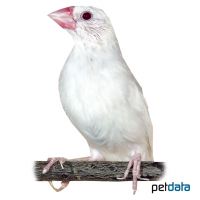Java Sparrow White (Lonchura oryzivora)
| Java Sparrow White Lonchura oryzivora | |
|---|---|
| Name | Java Sparrow White |
| Name Lat. | Lonchura oryzivora |
| Family | Estrildid Finches |
| Family lat. | Estrildidae |
| Order | Perching Birds |
| Order lat. | Passeriformes |
| Origin | Southeast Asia |
| Climate | Subtropical - tropical |
| Diet | Finch seed, herbage, insects, fruits |
| Keeping | Pair, group |
| Care Level | Easy |
| Reproduction | Finch nest |
| Life Span | 5-10 years |
| Protection | CITES Appendix II; EC Annex B |
| Metric Units | |
| Size | 14 cm |
| Temperature | Room temperature |
| Housing | 120 x 50 x 50 cm |
| US Units | |
| Size | 5.5" |
| Temperature | Room temperature |
| Housing | 45" x 20" x 20" |
Distribution and habitat
The rice finches originate from Bali and Java and have been naturalized in Malaysia, East Africa and Hawaii. They live in sparse forests and cultivated landscapes, often near rice and grain fields, usually in small flocks. They are bred in some color mutations and are now considered domesticated.
Cage size
The minimum cage size is 120 x 50 x 50 cm (L x W x H) for 2-4 animals. The cage must be placed in a bright, draught-free and quiet place at a height of at least 80 cm (except aviaries), have a rectangular base and be opaque on three sides, aviaries on one side. Keeping in an aviary (e.g. 150 x 70 x 150 cm) is preferable. Birds kept in a cage should be allowed daily controlled indoor free flight without danger after a period of acclimatization.
Maintenance
The floor must be covered with sand, wood granulate, bark mulch or similar material and must be cleaned regularly. At least 3 perches made of wood or branches of different thickness and height must be installed in such a way that they can only be reached by flying and that the longest possible flight distance is created. They need a bathing opportunity as well as biotope-like hiding, sleeping and nesting possibilities. It is recommended to provide them with grasses, twigs and bushes. They should be kept at room temperature, between 18 and 25 °C.
Diet
The species-specific feed offer consists of mixed seeds, available in specialized trade as "exotic feed" in premium quality, supplemented with foxtail millet, green feed (chickweed, green panicle millet, fresh grass panicles, etc.), paddy rice, insect feed, fruit and especially germinated seeds (paddy rice, wheat, egg feed and insect larvae, such as small cut-up meats).), paddy rice, insect feed, fruit and especially for raising young germinated seeds (paddy rice, wheat), egg feed and insect larvae, such as small, cut-up mealybug larvae, pinkies and small buffalos, as well as hard-boiled hen egg, mixed (crumbly) with exotic egg feed. Charcoal, vitamin lime and shell grit are needed as digestive aids. Drinking water must always be available in birdbaths or in stable, open containers. Food and water must be offered fresh daily, and the containers must be cleaned beforehand.
A varied diet promotes health and prevents deficiency symptoms.
Reproduction and breeding
The sexes can be distinguished by the song, because only the males sing and their beak is more reddish in color. They breed in semi-open or closed medium nest boxes. Suitable nesting materials include sisal, coconut fibers, long grasses, and animal hair and feathers for padding. The clutches consist of 4-6 eggs, the incubation period is about 13 days. The breeding season is, biologically speaking, year-round. When breeding, the room temperature should be at least 18 °C.
Species protection
The animal population must be reported to the competent authority in writing immediately after the start of keeping. Your pet store will be happy to provide you with further information.
Protection of species: WA Appendix II; EU Appendix B. The proof of purchase is the required proof of origin for the animal. Please keep it safe!
Important
They must not be kept in a round cage. For flock keeping, an aviary is required. When kept in an outdoor aviary (at least 1.70 m high), they also need a heated shelter of at least 1 m² floor space, which can be visited by the birds at any time. The temperature in the shelter must not fall below 15 °C and the furnishings must correspond to those of cage keeping
They may only be kept in pairs or in a group or flock. Socialization with other finches is possible. In rooms, including shelters, sufficient daylight or flicker-free artificial light (stroboscopic effect) corresponding to daylight must be provided. The lighting duration shall be 8-14 hours per day and the natural day-night rhythm shall be observed. Adequate indoor climate shall be provided. The health condition of the birds shall be checked daily
Further literature can be found in your pet store.
References
Text: Othmar Sieberer; Image: petdata
Source: BMEL (1995): Tierschutzgutachten - Mindestanforderungen an die Haltung von Kleinvögeln; BMEL-Haustier-Berater.de; BIELFELD (1996): Das Prachtfinken-Buch, Verlag Eugen Ulmer; GRUMMT & STREHLOW (2009): Zootierhaltung - Tiere in menschlicher Obhut: Vögel, Verlag Harri Deutsch
- Gemäß § 21 Abs. 5 Tierschutzgesetz idgF
